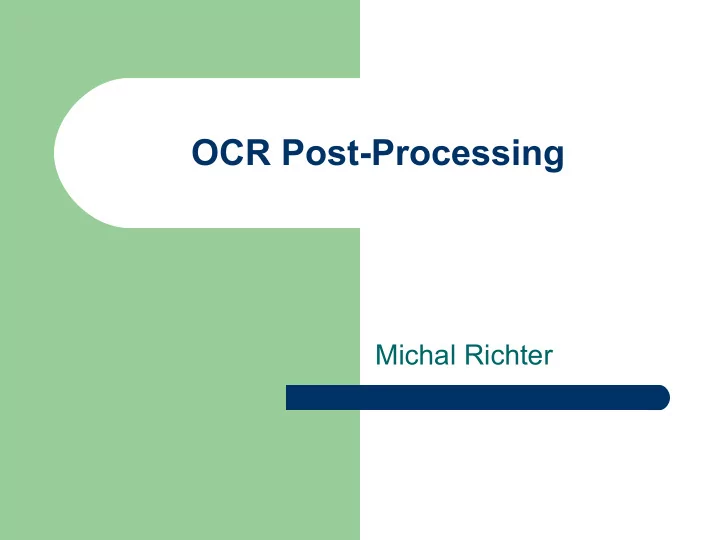

OCR Post-Processing Michal Richter
Noisy channel approach I Scanning of the document and OCR introduce errors – noise Post – processing step reduce the number of errors
Noisy channel approach II Post – processing corrects one sentence at the time. OCR output is modified by small amount of editing operations including: – single character insertion – single character deletion – single character substitution – multiple character substitution ( ab → ba ) – word split, word merge
Intuitive describtion In post-processing we want to replace the input sequence of characters with another sequence of characters that is graphically similar and form the likeable sentence of the given language These two aspect are handled separately
General form of the model P( O, S ) = P( O | S ) * P(S) O – output of the OCR system S – candidate sequence of character P( O | S ) – probability, that the sequence S will be recognized as O by OCR – corresponds to optical similarity between O and S – usually denoted as error model P( S ) – probability of S – corresponds to the likeabelness of the sequence S – this quantity should have greater value for well-formed sentences – denoted as language model
Language model – P( S ) Word based – Uses lexicon – sequence of characters is identified with the item in the lexicon – Smoothness of the sentence is ensured by word based n-gram model ( usually trigram ) – Problem: High coverage lexicon and huge amount of on-line text needed ( for n-gram model estimation )
Language model – P( S ) Character based – Smoothness of the sentence is ensured on the character level – No need of lexicon, lower amount of training data needed for language model estimation – Character based language model used (even 6-gram is possible)
Error model – P( O | S ) Levenshtein distance – Number of insertions, deletions and substitutions needed to transform input into the target – Example: LD between kitten and sitting is 3 kitten → sitten → sittin → sitting Modified Levenshtein distance – Editing operations have different costs according to their probability – Example: low cost for in ↔ m, high cost for w ↔ R
Error model – P( O | S ) Word segmentation – Can be treated by word segmentation model P(O, b, a,C) = P(O, b|a,C)P(a|C)P(C) – Another possibility is to avoid special treatment of the space character – word segmentation errors are corrected via insertion/deletion of space character
Search of the correct sentence S Viterbi decoding Weighted Finite State Transducers – Language model and error model are represented in the form of finite state transducers – Make the composition of the automaton representing OCR output with the automaton representing error model and language model – Find the shortest path in the composed transducer – blackboard?
Post-correction accuracy measure Word error rate metric
Post-correction accuracy (Kolak, Resnik; 2005) – WER reduction up to 80% – African language Igbo – Character based model – Miniature size training data – 6727 words!
Post-correction for historical domain Insufficient amount of training data ( if any ) Usually absence of high-coverage lexicons → This implies, that the use of word based approach is often impossible
References Okan Kolak; Philip Resnik. OCR Post- Processing for Low Density Languages. EMNLP-2005.
Recommend
More recommend